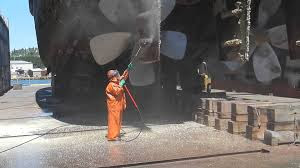This blog has evolved over the past year or so.
It began as my notes about the things I was reading in the literature published by LDS scholars and educators on the topic of Book of Mormon geography and historicity. That progressed into more detailed analysis and comment.
And I suggest it’s time to sail the ship of Book of Mormon geography into fresh water.
_________________
President Monson has used this metaphor in the past, so I’ll copy his comments here and then explain how that metaphor describes what I’m trying to do here.
An inspiring lesson is learned from a “Viewpoint” article which appeared some time ago in the Church News. May I quote:
“To some it may seem strange to see ships of many nations loading and unloading cargo along the docks at Portland, Ore. That city is 100 miles from the ocean. Getting there involves a difficult, often turbulent passage over the bar guarding the Columbia River and a long trip up the Columbia and Willamette Rivers.
“But ship captains like to tie up at Portland. They know that as their ships travel the seas, a curious saltwater shellfish called a barnacle fastens itself to the hull and stays there for the rest of its life, surrounding itself with a rocklike shell. As more and more [of these] barnacles attach themselves, they increase the ship’s drag, slow its progress, decrease its efficiency.
“Periodically, the ship must go into dry dock, where with great effort the barnacles are chiseled or scraped off. It’s a difficult, expensive process that ties up the ship for days.
“But not if the captain can get his ship to Portland. Barnacles can’t live in fresh water. There, in the sweet, fresh waters of the Willamette or Columbia, the barnacles die and some fall away, while those that remain are easily removed. Thus, the ship returns to its task lightened and renewed.
“Sins are like those barnacles. Hardly anyone goes through life without picking up some. They increase the drag, slow our progress, decrease our efficiency. Unrepented, building up one on another, they can eventually sink us.
“In His infinite love and mercy, our Lord has provided a harbor where, through repentance, our barnacles fall away and are forgotten. With our souls lightened and renewed, we can go efficiently about our work and His.”3
_________________
Lest anyone infer that I’m comparing theories about Book of Mormon geography to sin, I am most definitely not. Instead, I’m using the metaphor of barnacles to show how clear and simple teachings can become encrusted over the years.
In Letter VII, Joseph and Oliver were as clear, precise, and specific as they could be when they declared the Hill Cumorah in New York is the location of the final battles of the Nephites and Jaredites. Although it was originally published in Kirtland in 1835, Joseph saw that Letter VII was republished in Nauvoo, Philadelphia, and England so everyone would know about it.
Joseph F. Smith republished it in the Improvement Era. Joseph Fielding Smith republished part of it in the 1930s and again in the 1950s. As recently as 1975 and 1978, two Apostles reaffirmed the teaching in General Conference.
The New York setting for Cumorah is simple and clean.
But like ships at sea, the question of Cumorah has become encrusted with barnacles of confusion, doubt, and contention. RLDS scholars determined that New York was too far from the Mesoamerican sites they identified as locations of Book of Mormon events. LDS scholars, over the objection of Joseph Fielding Smith, adopted the RLDS position and added even more confusion. Barnacles grew thicker. They reached the point of claiming Joseph, Oliver, David Whitmer, Lucy Mack Smith, and others were unreliable and untrustworthy as witnesses.
As Joseph Fielding Smith warned, these barnacles have caused members of the Church (and investigators) to become confused. Members have become disturbed in their faith in the Book of Mormon when LDS scholars and educators teach that Joseph and Oliver were speculating and, worse, were wrong.
As President Monson observed, “As more and more of these barnacles attach themselves, they increase the ship’s drag, slow its progress, decrease its efficiency… But not if the captain can get his ship to Portland. Barnacles can’t live in fresh water. There, in the sweet, fresh waters of the Willamette or Columbia, the barnacles die and some fall away, while those that remain are easily removed. Thus, the ship returns to its task lightened and renewed.”
I repeat: it is time to sail the ship of Book of Mormon geography into fresh water.
Let’s let those barnacles die off and fall away.
Then the ship can return to its task, lightened and renewed by the clarity and simplicity of what Joseph and Oliver taught in the first place.
I hope that some day, LDS scholars and educators will concur. I hope some day they will help scrape off whatever barnacles remain.
But as long as they resist, ignore them. As members of the Church, we are not bound by what they say. We can each make our own decisions about Letter VII and the teachings of the prophets and apostles on the location of Cumorah.
Source: Book of Mormon Wars

